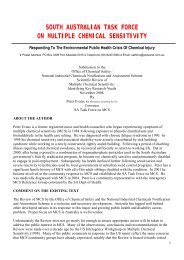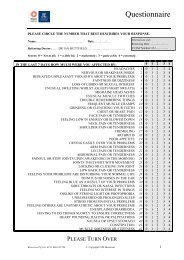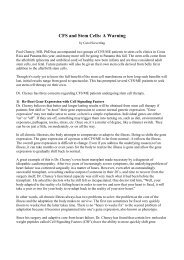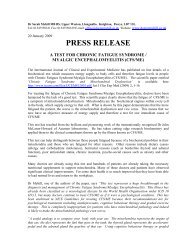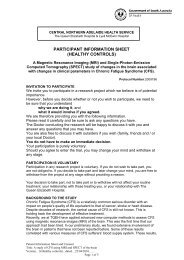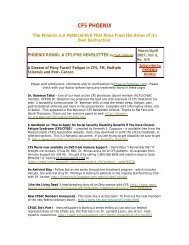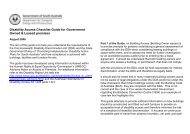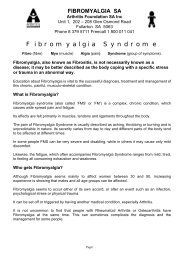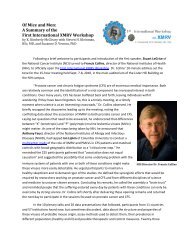1813 01 REUMA3 Editoriale - ME/CFS Australia
1813 01 REUMA3 Editoriale - ME/CFS Australia
1813 01 REUMA3 Editoriale - ME/CFS Australia
You also want an ePaper? Increase the reach of your titles
YUMPU automatically turns print PDFs into web optimized ePapers that Google loves.
Fibromyalgia syndrome: the pharmacological treatment options 53be considered as a systemic disease that is relatednot only to neurotransmission imbalance, but alsoto other neurotrophic, neurosteroidal, CNS hormonalmodifications and diffuse, autonomic, immunologic,and metabolic somatic changes (8, 21).According to this hypothesis, antidepressants restoreneurotransmitter levels and modulate receptorexpression in the hypothalamus, which normalizeshyperactivity of the hypothalamic-pituitary-adrenal(HPA) axis (18, 1). An over-activationof the HPA axis is observed in depression and inchronic stress, both of which are frequently presentin patients with long-term pain disorders. Conversely,the response to stress is considered to playa crucial role in the pathogenesis of several syndromes,such as FM, chronic fatigue syndrome andirritable bowel syndrome (22, 23). Similarly, autonomicsystem alterations, such as sympatheticoveractivity, are present in both depression and FM(21). Finally, pro-inflammatory cytokines withinthe CNS play a role in the pathophysiology ofmood disorders (and pain), and modulating thesecytokines via chronic antidepressant treatment contributeto improve depression (and pain) (24).Several studies reported high frequency of mooddisorders in FM patients (25, 26) compared to controls(27). Short-term clinical studies have shownefficacy for antidepressants in the treatment of FM(28).Abnormalities in central monoaminergic neurotransmissionthat are observed in depression mightplay a role in FM pathophysiology because dysfunctionof 5-HT– and NE-mediated descendingpain-inhibitory pathways is an important mechanismrelated to the pain experienced by FM patients.Antidepressants that increase 5-HT and NEmediatedneurotransmission are commonly used totreat FM and other chronic pain conditions, particularlyneuropathic pain. Inhibition of both the 5-HTand NE reuptake transporters using tricyclic antidepressants(TCA) or SNRIs (serotonergic and noradrenergicreuptake inhibitors), seems more effectivein treating pain, and FM, in general, than inhibitionof either transporter alone using selectiveserotonergic (SSRIs) or noradrenergic (NARIs) reuptakeinhibitors (29-31).However, the efficacy of TCAs is counterbalancedby side effects (32, 33), while the better-toleratedSSRIs demonstrate less effectiveness in treating fibromyalgia(34-37).Antidepressants acting both on NE and 5HT inducea contextual increase of the endogenous opioidsystem response that raises the pain thresholdat the periacqueductal level and increases the gatecontrol of nociception at the spinal cord level (38).Antidepressants usually produce a fast, direct analgesiceffect (on opioid, enkephalinergic, substanceP) that is independent of mood state; it first appearsafter a few hours and can be achieved withlow doses.After a longer period of 2-3 weeks, a more robustanalgesic effect develops when antidepressantshave a more profound influence on mood and anxiety,and the affective and cognitive components ofpain become regulated. This effect can only be producedwith full doses that are easier to achieve withthe new generation of antidepressants, such as SS-RIs and SNRIs (39, 40).Concerning the use of antidepressants in fibromyalgia,Perrot and colleagues (41) identifiedforty-nine publications on the use of antidepressantsto treat painful rheumatologic conditions (including37 studies and 12 meta-analyses) that wereconsidered valid and used to develop the followingconsiderations: the analgesic effect is higher forTCAs than SSRIs; clear evidence concerning doseresponsedoes not exist; the onset of action occurswithin a week; the route of administration is oral;and side effects are more prevalent in TCAs thanSSRIs. Unfortunately, this review included studiesTable I - Summary of the controlled studies of dual reuptake inhibitors (SNRI).Authors References Drug N. Pts Weeks Dose Outc. ResultsArnold, 2004 43 DUL vs PLA 207 12 120 FIQ DUL > PLARussell, 2008 44 DUL vs PLA 520 24 20-120 BPIPGIDUL > PLAVitton et al., 2005 45 MIL vs PLA 125 4 200 PGIFIQMIL > PLAArnold, 2005 46 DUL > PLA 354 12 60-120 BPI DUL > PLAVLF = venlafaxine; DUL = duloxetine; MIL = milnacipran; dose in mg/day; outc. = outcome measures: VAS = Visual Analog Scale; FIQ = Fibromyalgia Impact Questionnaire;



